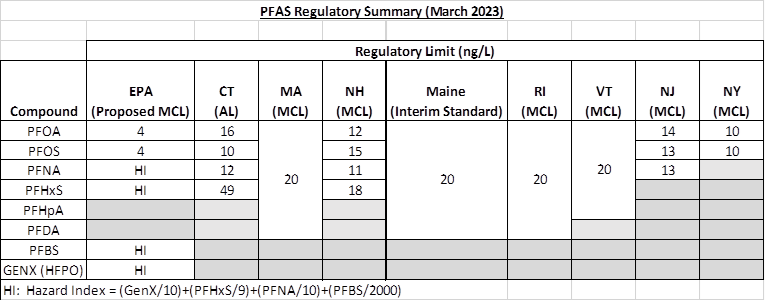Staying Ahead of PFAS
EPA Releases Proposed Maximum Contaminant Level (MCL) for PFAS
By Ryan C. Fleming, PE, Peter Galant, PE, Jeffrey Arps, LSP
For those working in the drinking water industry, EPA’s recent announcement of proposed MCLs for per- and polyfluoroalkyl substances did not come as a surprise. On March 14, EPA issued the proposed rule that would set MCLs for PFOA and PFOS at 4.0 parts per trillion (ppt) each. Also, for the first time ever in drinking water, EPA introduced a “Hazard Index” (HI) that will be used to regulate four additional PFAS compounds – HFPO-DA (GenX), PFBS, PFNA, and PFHxS. A total HI above 1.0 for these compounds individually or in combination would exceed the MCL.
EPA is seeking public comment on the proposed rule for a period of 60 days following publication in the Federal Register and expects to finalize the rule by September 2023, if not sooner. Once the rule is finalized, drinking water systems will have 3 years to comply with the new MCLs.

What does the proposed MCL mean for public water systems?
Public officials and water industry managers have known that the proposed MCL for PFOA and PFOS was imminent. The Hazard Index calculation, however, adds some complexity in terms of compliance and communications. Based on occurrence data and other factors, many water systems in the Northeast may not have data for all four of the compounds required in the calculation (e.g., GenX) or have samples that meet the new (lower) analytical test detection limits.
Furthermore, many northeastern states have already established regulations for PFAS compounds based on singular concentrations, a sum of selected compounds, or a combination of the two. After the proposed new rule is finalized, State Primacy Agencies will have to adapt their regulations to be at least as stringent as the federal standard. This means that there are water systems who currently comply with their state’s regulations but could find themselves out of compliance with the new federal rule.
How can Tighe & Bond help?
In concert with the proposed MCL issuance, the federal government appropriated funding specifically to address PFAS in drinking water, which could help offset some of the financial burden water utilities face. Tighe & Bond has experience assisting public water systems with grant applications, as well as managing the design, bidding, and construction oversight. We also recognize that regulation of PFAS compounds at both the state and federal levels will continue to evolve, and treatment system designs must integrate flexibility/adaptability to account for this uncertainty. Additionally, utilities will need an effective operations plan and communication strategy to reassure customers that they’re taking the right steps to comply with these new regulations and protect public health. Whatever the challenge your system faces, Tighe & Bond’s team of engineers and scientists are here to help.
Resources
The proposed rule landing page
FAQs for Drinking Water Primacy Agencies
Proposed PFAS National Primary Drinking Water Regulation Frequently Asked Questions and Answers
Understanding the Hazard Index Fact Sheet
Tags: PFAS


